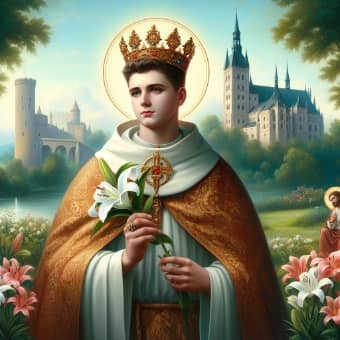The Life and Legacy of St. Casimir of Poland
Prince of Piety and Patron Saint
The history of European nobility is replete with tales of valor, power, and sanctity, but few stories resonate with the devout fervor and exemplary life led by St. Casimir of Poland.
Born into the luxuries of royal life in the 15th century, St. Casimir chose a path of spiritual depth over temporal rule, becoming a symbol of piety and dedication to the Catholic faithful. His feast day, celebrated on March 4, commemorates a life of humility, kindness, and unwavering faith.
This blog post contains affiliate links. When you click on a link on this page and make a purchase I may earn a small commission, at no additional cost to you. Thank you for your support.
Early Life and Royal Heritage
St. Casimir was born on October 3, 1458, into the royal family of Poland. He was the second of thirteen children to King Casimir IV Jagiellon and Queen Elizabeth of Austria, both of whom hailed from prestigious European dynasties.
From a young age, Casimir was noted for his religious inclination and devotion. Amid the opulence that surrounded him, Casimir remained grounded in the virtues of humility and charity.

Ascetic Pursuits and Rejection of the Throne
Rather than seek the comfort typically enjoyed by royalty, Casimir embraced an ascetic lifestyle, much to the astonishment of his contemporaries. He spent considerable time in prayer and meditation, often sleeping on the floor to practice self-denial. His love for the Eucharist and the Virgin Mary formed the cornerstone of his deep spiritual life.
Despite being a prince and in line for succession to the throne, St. Casimir chose not to pursue a life of political power. When the opportunity arose to claim the crown of Hungary, he rejected the prospect, opting instead to devote his life to God and serve his people through his faith and charitable acts.
Patronage and Miracles
St. Casimir became well-known for his generosity and concern for the poor; he was often seen distributing food and clothing to the needy. His commitment to the downtrodden was not just limited to material help. Casimir was also a voice of moral guidance, encouraging those around him to lead lives of virtue and to find strength in their spiritual beliefs.
Many miracles were attributed to St. Casimir during and after his short life—he died at the age of 25 on March 4, 1484. Reports of healings and other miraculous events led to his canonization in 1522 by Pope Adrian VI. St. Casimir’s tomb became a pilgrimage site and has been associated with numerous signs of divine favor.
Continuing Influence and Feast Day
St. Casimir’s influence extends beyond the borders of Poland and Lithuania (of which he is also a patron saint). His dedication to purity and devout service is an inspiration to Catholics around the world. The annual celebration of his feast day is a time for reflection and praise for the young prince’s commitment to his faith, even in the face of royal responsibilities and potential earthly power.
Conclusion
St. Casimir of Poland remains an enduring icon for those seeking a model of holy living within the temptations and responsibilities of worldly life.
His legacy is a testament to the enduring power of spiritual virtues over temporal ambitions. It reminds us that true leadership and legacy are not only measured in political achievements or territorial conquests but also in the profound impact of spiritual resolve and humble service to humanity.
